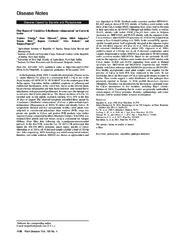Приказ основних података о документу
First Report of ‘Candidatus Liberibacter solanacearum’on Carrot in Serbia
| dc.creator | Trkulja, Vojislav | |
| dc.creator | Mitrović, Petar | |
| dc.creator | Mihić Salapura, Jelena | |
| dc.creator | Iličić, Renata | |
| dc.creator | Ćurković, Bojana | |
| dc.creator | Đalović, Ivica | |
| dc.creator | Popović Milovanović, Tatjana | |
| dc.date.accessioned | 2023-07-12T09:51:11Z | |
| dc.date.available | 2023-07-12T09:51:11Z | |
| dc.date.issued | 2021 | |
| dc.identifier.issn | 0191-2917 | |
| dc.identifier.issn | 1943-7692 | |
| dc.identifier.uri | https://plantarum.izbis.bg.ac.rs/handle/123456789/654 | |
| dc.description.abstract | At the beginning of July 2020, 3-month-old carrot plants (Daucus carota L. variety Maestro F1) grown in a commercial field 1.2 ha in size at the Begeč locality (45°14′30.38″ N, 19°36′44.82″ E) in the southern part of the Bačka region, Vojvodina, Serbia, exhibited symptoms of yellowing and reddish leaf discoloration. At the end of July, leaves on the infected plants became bronze and purplish, and their shoots and roots were stunted due to dehydration, with pronounced proliferation. In some cases, the damage was so extensive that it led to plant decay. The disease incidence of 0.5 to 1% recorded early in July rapidly escalated, reaching 10 to 15% in the first 10 days of August. The observed symptoms resembled those caused by ‘Candidatus Liberibacter solanacearum’ (CaLso), a phloem-limited proteobacterium (Munyaneza et al. 2015). To detect and identify CaLso, 15 symptomatic diseased and five asymptomatic healthy carrot plants were subjected to conventional polymerase chain reaction (PCR) using two primer sets specific to CaLso, and positive PCR products were further sequenced using commercial facilities (Macrogen Europe). Total DNA was extracted from petiole and root tissues using a commercial kit (Qiagen DNEasy Plant Mini Kit) following the manufacturer-recommended protocol. In the first PCR, using the Lso TX 16/23 F/R primer pair that targets the 16S-23S rRNA intergenic spacer region specific to CaLso (Ravindran et al. 2011), all 15 diseased samples yielded a band of 383-bp size. After sequencing, 100% homology was noted among tested isolates; therefore, one isolate coded as 1842/20 was chosen as representative and was deposited in NCBI GenBank under accession number MT948144. BLAST analysis showed 99.70% identity of Serbian carrot isolates with those of the CaLso isolate 80022 originating from celery seed in Slovenia or Italy (accession no. KY619977) (Monger and Jeffries 2018), as well as 99.41% identity with isolate GBBC_Clso_03 from carrot in Belgium (accession no. MH734515) and 98.22% identity with the sequence of the CaLso reference strain NZ082226 (accession no. EU834130) isolated from tomato in New Zealand (Liefting et al. 2009). In the second PCR, species-specific forward primer LsoF empirically designed at the signature region of the 16S rRNA sequence of CaLso (Li et al. 2009) in combination with the universal Liberibacter reverse primer OI2c (Jagoueix et al. 1996) yielded a target of 1,163-bp size in all 15 diseased symptomatic carrot samples. Representative isolate 1842/20 was deposited in NCBI GenBank under accession number MW187524. Based on the nucleotide BLAST analysis, the sequence of Serbian carrot isolate showed 100% identity with CaLso strains 16-004 and 16-011 originating from carrot in Finland (accession nos. MG701014 and MG701015, respectively) and 99.64% identity with CaLso reference strain NZ082226 (accession no. EU834130). Five healthy asymptomatic carrot plant samples were negative for the presence of CaLso in both PCR tests employed in this work. To our knowledge, this is the first report of CaLso causing the disease in carrot in Serbia. These results suggest a wider distribution of this pathogen than previously reported in Europe. In 2014, psyllid Bactericera trigonica (Hemiptera, Triozidae) was described for the first time as a potential vector for CaLso transmission in few localities, including Begeč (Jerinić-Prodanović 2014). Considering that its vectors are presently unidentified, certain aspects of CaLso genomics, diversity, epidemiology, and vector dynamics will be studied further in future investigations. | sr |
| dc.language.iso | en | sr |
| dc.publisher | American Phytopathological Society | sr |
| dc.rights | openAccess | sr |
| dc.rights.uri | https://creativecommons.org/licenses/by-nc-nd/4.0/ | |
| dc.source | Plant Disease | sr |
| dc.subject | prokaryotes | sr |
| dc.subject | vegetables | sr |
| dc.subject | pathogen detection | sr |
| dc.title | First Report of ‘Candidatus Liberibacter solanacearum’on Carrot in Serbia | sr |
| dc.type | Информативни прилог | sr |
| dc.rights.license | BY-NC-ND | sr |
| dc.citation.issue | 4 | |
| dc.citation.rank | M21 | |
| dc.citation.spage | 1188 | |
| dc.citation.volume | 105 | |
| dc.type.version | publishedVersion | sr |
| dc.identifier.doi | 10.1094/PDIS-11-20-2384-PDN | |
| dc.identifier.fulltext | http://plantarum.izbis.bg.ac.rs/bitstream/id/2706/bitstream_2706.pdf | |
| dc.identifier.scopus | 2-s2.0-85105099473 | |
| dc.identifier.wos | 000663991900061 |


